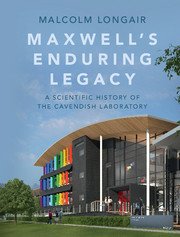Book contents
- Frontmatter
- Dedication
- Contents
- Preface
- Acknowledgements
- Part I To 1874
- Part II 1874 to 1879
- Part III 1879 to 1884
- Part IV 1884 to 1919
- Part V 1919 to 1937
- Part VI 1938 to 1953
- Part VII 1953 to 1971
- Part VIII 1971 to 1982
- 16 The Pippard era: a new Laboratory and a new vision
- 17 The Pippard era: radio astronomy, high–energy physics and laboratory astrophysics
- 18 The Pippard era: condensedmatter physics
- Part IX 1984 to 1995
- Part X 1995 to present
- Appendix The evolution of the New Museums site
- Notes
- References
- Author index
- Subject index
17 - The Pippard era: radio astronomy, high–energy physics and laboratory astrophysics
from Part VIII - 1971 to 1982
Published online by Cambridge University Press: 05 July 2016
- Frontmatter
- Dedication
- Contents
- Preface
- Acknowledgements
- Part I To 1874
- Part II 1874 to 1879
- Part III 1879 to 1884
- Part IV 1884 to 1919
- Part V 1919 to 1937
- Part VI 1938 to 1953
- Part VII 1953 to 1971
- Part VIII 1971 to 1982
- 16 The Pippard era: a new Laboratory and a new vision
- 17 The Pippard era: radio astronomy, high–energy physics and laboratory astrophysics
- 18 The Pippard era: condensedmatter physics
- Part IX 1984 to 1995
- Part X 1995 to present
- Appendix The evolution of the New Museums site
- Notes
- References
- Author index
- Subject index
Summary
The Mullard Radio Astronomy Observatory
The extragalactic radio sources
The construction of the One-Mile and Five-Kilometre (Ryle) telescopes opened up the study of the astrophysics of galactic and extragalactic radio sources. The radio emission of these sources had been established as the synchrotron radiation of ultra-relativistic electrons gyrating in the magnetic fields within the radio sources. The One-Mile Telescope carried out deep surveys of small regions of sky which demonstrated the convergence of the number counts of radio sources at low flux densities (Section 14.3), a key result for astrophysical cosmology. In addition, over the three years from 1965, complete samples of radio sources were imaged with an angular resolution of about 23 arcsec at 1.4 GHz, using the telescope as a grating synthesis instrument. The positions and structures of over 200 of the brightest extragalactic sources in the northern sky were determined, the results of this large programme being published in three papers in the late 1960s (Macdonald et al., 1968; Mackay, 1969; Elsmore and Mackay, 1969). With these data, it was possible to begin the astrophysical analysis of the population of powerful extragalactic radio sources (Longair and Macdonald, 1969). The vast majority of them were double-lobed sources, associated both with radio galaxies and with radio quasars, but the details of their structures were not resolved.
With the success of the mapping of the sources at 0.408 GHz and 1.4 GHz, the next challenge was to develop receivers for the One-Mile Telescope for the higher frequencies of 2.7 GHz and 5 GHz, providing three times greater angular resolution at the higher frequency. As always, Cygnus A was the first target because of its enormous flux density compared with all other powerful extragalactic radio sources in the northern sky. Simon Mitton and Martin Ryle (1969) published radio maps of Cygnus A at these higher frequencies; the 5 GHz map is shown in Figure 17.1. These observations showed convincingly that there are regions of very high energy density in relativistic electrons and magnetic fields in the compact radio structures observed towards the ‘leading edge’ of the radio structures. There was clearly much to be understood from observations with yet higher angular resolution and, this was to be provided by the Five-Kilometre Telescope, which was designed to have outstanding performance at 5 GHz.
- Type
- Chapter
- Information
- Maxwell's Enduring LegacyA Scientific History of the Cavendish Laboratory, pp. 414 - 435Publisher: Cambridge University PressPrint publication year: 2016



